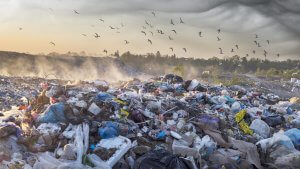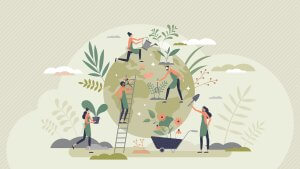
As this year’s UN climate summit (COP28) gets underway, it’s crucial that we recognise the critical role that textile businesses can play in helping tackle climate change.
Globally, it’s estimated that the sector generates 92 million tonnes of waste each year¹, with less than 1% of all textiles being recycled into new products². Ian Burn, director of marketing and sustainability at Camira, shares his insight into how closed loop textiles will shape the future of the industry, and how modern technology can support a circular economy.
The problem
The manufacturing of textiles uses a great deal of natural resources, primarily petro-chemical based synthetics, and creates greenhouse gases which are responsible for global warming. According to the UN, the industry is responsible for 8-10% of global emissions – more than aviation and shipping combined³.
Concerningly, global warming was the main driver of the extreme weather experienced in South America in November this year, with temperatures soaring above 40°C in some parts of Brazil, Paraguay and Argentina⁴. Global warming is also to blame for Storm Babet which swept across parts of Eastern Scotland in October and the fires in Greece during the summer. It’s clear that new strategies must be adopted in the textile sector in order counteract the negative effects of fast fashion to extend the lifespan of textiles, and reduce their impact on the environment, to help protect our planet.
A time for change
Large-scale systemic change is needed for the industry to align with the Paris Climate Change Agreement’s goals which is to limit global warming to 1.5 °C, above pre-Industrial Revolution levels. Textile leaders must work together to develop, share and scale new processes to ignite this change. Embracing innovative technologies such as optical scanning, robotics and AI will overcome barriers to textile circularity, and support the transition to a more circular economy.
This year, the UK Fashion and Textiles Association (UKFT) announced that it would lead a £4 million project to develop a fully integrated, automated sorting and pre-processing demonstrator for waste textiles, which could eventually divert thousands of tonnes from landfill each year.
The Autosort for Circular Textiles Demonstrator (ACT UK) is a two-year project which will support the transition from uneconomic manual sorting of clothes and textiles that are not suitable for resale, to highly automated sorting and pre-processing, which can then be used as feedstock for existing and emerging recycling processes. Camira is an industry partner within a consortium of textile businesses, retailers and academia, providing specialist knowledge for this project in the area of textile recycling.
Bringing back ‘shoddy’
Camira’s expertise in textile recycling comes from its investment in wool recycling company, iinouiio in 2022. This employs advanced reprocessing machinery to convert high value raw materials, from textile manufacturing waste and preloved wool and cashmere products, into fibre, which can be re-spun and made into new yarn and fabric.
iinouiio’s technology, which is inspired by the process of ‘shoddy’ manufacturing, established in the 1800’s, has seen Camira develop its first circular fabric, using 31% recycled content, generated from its own manufacturing waste. The next stage is to increase the level of recycled content in the fabric, creating a new product which includes 75% recycled content, launching in summer 2024.
Clearly, using recycled content extends the lifespan of precious natural resources, but to understand the tangible benefits of using recycled wool, compared to virgin wool, The University of Huddersfield’s School of Applied Sciences conducted a Life Cycle Assessment (LCA) which showed that using recycled wool reduces all environmental impact categories, including the key aspects of global warming potential, abiotic depletion (fossil fuels) and water depletion.
Natural fibres
The use of natural fibres in textiles can be traced back thousands of years, but the onset of man-made oil-based synthetics from around the 1930s onwards led to a rapid shift towards polyester as the global fibre of choice. With the impact of climate change and global warming, however, there is a resurgence of interest in plant fibres such as hemp, flax and jute.
Throughout its life cycle hemp has several important benefits for the environment. The hemp plant grows rapidly, absorbing carbon dioxide, improving biodiversity and producing a raft of sustainable products, from textile fibre to building materials. It also requires minimal energy during production and when the fibre is blended with wool provides inherent flame retardancy, with no additional chemical treatment required.
Looking to the future
As the world faces into the reality of climate change, the need for action is paramount and it is the responsibility of the textile industry to demonstrate alternative models, based on circular economy and regenerative principles, to lead the sector into a new age of sustainable practices and ultimately, a healthier planet.

Recognising excellence across the Asian Pacific.
Nominate now ➜
Read the latest and past issues of APAC Insider.
Explore issues ➜
Find out how we can help your business grow.
Find out more ➜



















